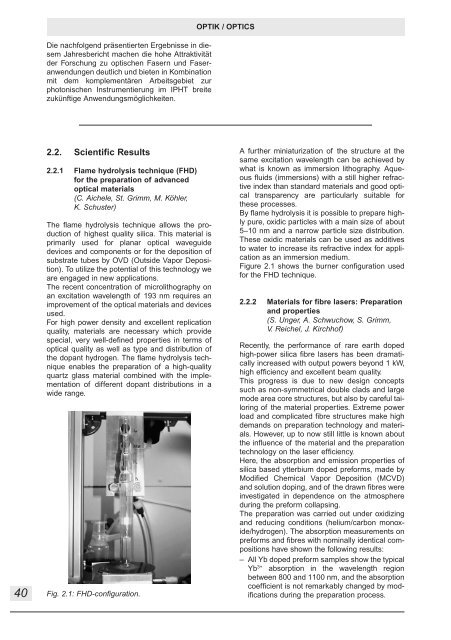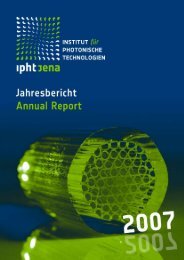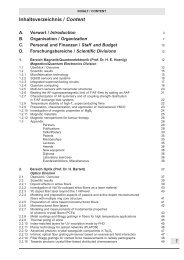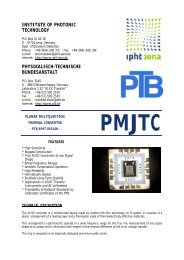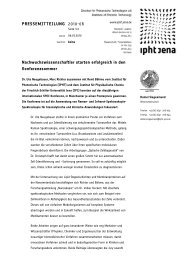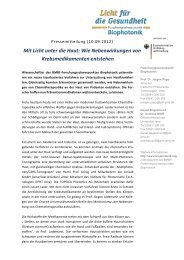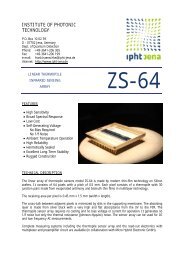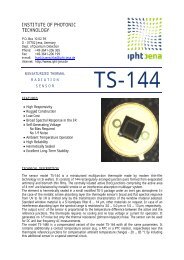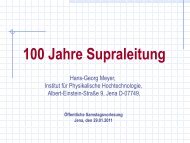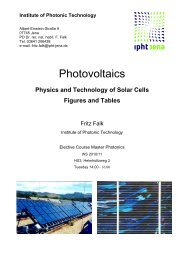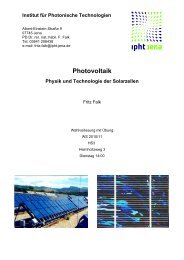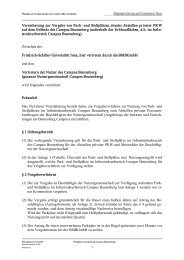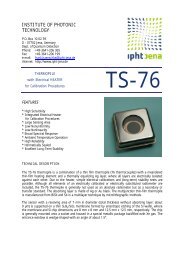Create successful ePaper yourself
Turn your PDF publications into a flip-book with our unique Google optimized e-Paper software.
Die nachfolgend präsentierten Ergebnisse in diesem<br />
Jahresbericht machen die hohe Attraktivität<br />
der Forschung zu optischen Fasern und Faseranwendungen<br />
deutlich und bieten in Kombination<br />
mit dem komplementären Arbeitsgebiet zur<br />
photonischen Instrumentierung im <strong>IPHT</strong> breite<br />
zukünftige Anwendungsmöglichkeiten.<br />
OPTIK / OPTICS<br />
40<br />
2.2. Scientific Results<br />
2.2.1 Flame hydrolysis technique (FHD)<br />
for the preparation of advanced<br />
optical materials<br />
(C. Aichele, St. Grimm, M. Köhler,<br />
K. Schuster)<br />
The flame hydrolysis technique allows the production<br />
of highest quality silica. This material is<br />
primarily used for planar optical waveguide<br />
devices and components or for the deposition of<br />
substrate tubes by OVD (Outside Vapor Deposition).<br />
To utilize the potential of this technology we<br />
are engaged in new applications.<br />
The recent concentration of microlithography on<br />
an excitation wavelength of 193 nm requires an<br />
improvement of the optical materials and devices<br />
used.<br />
For high power density and excellent replication<br />
quality, materials are necessary which provide<br />
special, very well-defined properties in terms of<br />
optical quality as well as type and distribution of<br />
the dopant hydrogen. The flame hydrolysis technique<br />
enables the preparation of a high-quality<br />
quartz glass material combined with the implementation<br />
of different dopant distributions in a<br />
wide range.<br />
Fig. 2.1: FHD-configuration.<br />
A further miniaturization of the structure at the<br />
same excitation wavelength can be achieved by<br />
what is known as immersion lithography. Aqueous<br />
fluids (immersions) with a still higher refractive<br />
index than standard materials and good optical<br />
transparency are particularly suitable for<br />
these processes.<br />
By flame hydrolysis it is possible to prepare highly<br />
pure, oxidic particles with a main size of about<br />
5–10 nm and a narrow particle size distribution.<br />
These oxidic materials can be used as additives<br />
to water to increase its refractive index for application<br />
as an immersion medium.<br />
Figure 2.1 shows the burner configuration used<br />
for the FHD technique.<br />
2.2.2 Materials for fibre lasers: Preparation<br />
and properties<br />
(S. Unger, A. Schwuchow, S. Grimm,<br />
V. Reichel, J. Kirchhof)<br />
Recently, the performance of rare earth doped<br />
high-power silica fibre lasers has been dramatically<br />
increased with output powers beyond 1 kW,<br />
high efficiency and excellent beam quality.<br />
This progress is due to new design concepts<br />
such as non-symmetrical double clads and large<br />
mode area core structures, but also by careful tailoring<br />
of the material properties. Extreme power<br />
load and complicated fibre structures make high<br />
demands on preparation technology and materials.<br />
However, up to now still little is known about<br />
the influence of the material and the preparation<br />
technology on the laser efficiency.<br />
Here, the absorption and emission properties of<br />
silica based ytterbium doped preforms, made by<br />
Modified Chemical Vapor Deposition (MCVD)<br />
and solution doping, and of the drawn fibres were<br />
investigated in dependence on the atmosphere<br />
during the preform collapsing.<br />
The preparation was carried out under oxidizing<br />
and reducing conditions (helium/carbon monoxide/hydrogen).<br />
The absorption measurements on<br />
preforms and fibres with nominally identical compositions<br />
have shown the following results:<br />
– All Yb doped preform samples show the typical<br />
Yb 3+ absorption in the wavelength region<br />
between 800 and 1100 nm, and the absorption<br />
coefficient is not remarkably changed by modifications<br />
during the preparation process.


